
Sound Substitutions
In the early stages of speech development, children make typical and systematic sound substitutions for speech sounds they haven’t yet mastered. At two years of age, children often use the ‘b’ sound instead of the later acquired ‘f’ sound (e.g. “bish” for ‘fish’). These sound substitutions form speech patterns that we typically expect and accept as part of ‘normal’ child speech. Many parents can understand their child’s early attempts at words, but the child’s limited repertoire of sounds, often results in word production errors that require some guesswork from parents. Children may use the same word attempt for several real words. For example “duh” may be used for ‘dog’, ‘duck’ and ‘cup’.
Speech Patterns or ‘Phonological Processes’
These sound substitutions are often called phonological processes by speech pathologists. Researchers have identified a number of phonological processes, or patterns, that children typically use along the journey towards adult-sounding speech. As with the acquisition of individual speech sounds, there are ages at which phonological processes are age-appropriate. Sometimes, children get stuck and continue to use phonological processes that are appropriate for younger children. Some children may also use unusual phonological processes that we don’t see as part of typical speech development. Both of these are examples of speech sound disorders.
Consistent or Inconsistent
Most of the time, phonological processes are a consistent pattern that children use systematically. Parents and caregivers may be able to ‘crack the code’ and understand what their child is saying, even when others cannot. However, sometimes children apply these patterns inconsistently and this can result in the same word sounding different each time (e.g. ‘butterfly’ = “bu-fly”, “bubberfly”). The inconsistent use of phonological processes, makes speech harder to understand, and may also indicate the presence of a speech sound disorder.
Speech Intelligibility or Speech Clarity
Researchers have identified typical patterns or expectations for speech intelligibility, for children at different ages. The chart below shows the speech intelligibility expected for children aged 19 months to 5+ years.
Expectations for Speech Intelligibility
Age | Intelligibility |
|---|---|
19-24 months | 25 - 50% |
2-3 years | 50 - 75% |
4-5 years | 75% - 90% |
5+ years | 90% - 100% |
Source: Pena-Brooks & Hegde (2007). Assessment and treatment of articulation and phonological disorders in children. Austin, TX: PRO-ED.
Concerns
If you have any concerns about your child’s speech sound substitutions or their intelligibility
and you or others are having difficulty understanding your child’s speech, enquire now at
Play My Way for advice and recommendations about the possible need for speech
pathology intervention.
